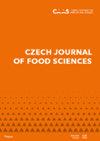Effect of Production System on Chemical Composition and Macro-Minerals of Sudanese camels Milk
IF 1
4区 农林科学
Q4 FOOD SCIENCE & TECHNOLOGY
引用次数: 0
Abstract
Purpose: This study was conducted to determine the production system effect on camel milk composition and macro-elements content in Sudan. Methodology: Sample purchased from camel milk production markets (Albutana- Tumbool, Kordfan-Elobied, and Khartoum-Alsalam market) in 6 replicates. Findings: There were no difference in moisture, and protein % among camel milk from different area, on the other hand there were significantly different in fat and ash content % with highest values for Khartoum camel milk and lowest values for Kordofan camel milk. Macro-minerals (Na, K, Mg, Ca, and P) content in camel milk were determined and there was different content. Ca, Na, K, Mg and P higher in Khartoum camel milk and lowest content values for Kordofan camel milk. The study was extended to determine soil macro-elements contents in Albutana and Kordofan areas which were fed by grazing system, and ignored soil in Khartoum whereas camels lives in a farm. Unique contribution to theory, practice and policy: Camels produce more milk of high nutritional quality and for a longer period of time than other species in an environment that might be rightly termed as hostile in terms of extreme temperature, drought and lack of pasture, in Sudan camel’s milk constitutes the sole diet of camel herders for considerable periods and they rely completely on camel’s milk for more than month without having drinking water especially during the migratory routes. Camel milk from different areas and production system had different chemical content in fat and ash % and similar in moisture and protein %, within the same season. However, macro-minerals in camel milk increasing by soil macro minerals contents specially on grazing system.生产制度对苏丹骆驼奶化学成分和常量矿物质的影响
目的:研究生产体制对苏丹骆驼奶成分和常量元素含量的影响。方法:在6个重复中从骆驼奶生产市场(Albutana- Tumbool、Kordfan-Elobied和Khartoum-Alsalam市场)购买样本。结果:不同产地骆驼奶的水分和蛋白质含量无显著差异,而脂肪和灰分含量有显著差异,喀土穆骆驼奶最高,科尔多凡骆驼奶最低。测定了驼奶中微量元素(Na、K、Mg、Ca、P)的含量,发现其含量不同。喀土穆骆驼奶中Ca、Na、K、Mg和P含量较高,科尔多凡骆驼奶含量最低。将研究扩展到放牧放牧的阿尔布塔纳和科尔多凡地区,以及忽略骆驼放牧的喀土穆地区土壤中常量元素含量的测定。对理论、实践和政策的独特贡献:在极端温度、干旱和缺乏牧场的恶劣环境中,骆驼比其他物种产更多高营养质量的奶,而且产奶时间更长。在苏丹,骆驼奶是骆驼牧民相当长一段时间的唯一饮食,他们在没有饮用水的情况下完全依赖骆驼奶超过一个月,尤其是在迁徙路线上。在同一季节,不同产地、不同生产制度的骆驼奶的脂肪、灰分化学含量不同,水分、蛋白质化学含量相近。而骆驼奶中微量元素含量随土壤微量元素含量的增加而增加,特别是放牧制度下。
本文章由计算机程序翻译,如有差异,请以英文原文为准。
求助全文
约1分钟内获得全文
求助全文
来源期刊

Czech Journal of Food Sciences
Food Science & Technology, Chemistry-食品科技
CiteScore
2.60
自引率
0.00%
发文量
48
审稿时长
7 months
期刊介绍:
Original research, critical review articles, and short communications dealing with food technology and processing (including food biochemistry, mikrobiology, analyse, engineering, nutrition and economy). Papers are published in English.
 求助内容:
求助内容: 应助结果提醒方式:
应助结果提醒方式:


